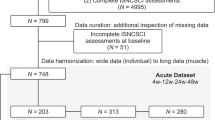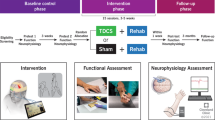Abstract
Background:
Automated sensor-based assessments of upper extremity (UE) function after cervical spinal cord injury (SCI) could provide more detailed tracking of individual recovery profiles than is possible with existing assessments, and optimize the delivery and assessment of new interventions. The design of reliable automated assessments requires identifying the key variables that need to be measured to meaningfully quantify UE function. An unanswered question is to what extent measures of sensorimotor impairment can quantitatively predict performance on functional tasks.
Objective:
The objective was to define the predictive value of impairment measures for concurrent functional task performance in traumatic cervical SCI, as measured by the Graded Redefined Assessment of Strength, Sensibility and Prehension (GRASSP).
Setting:
Retrospective analysis.
Methods:
A data set of 138 GRASSP assessments was analyzed. The Strength and Sensation modules were used as measures of impairment, whereas the concurrent Prehension Performance module was used as the surrogate measure of function. Classifiers were trained to predict the scores on each of the six individual tasks in the Prehension Performance module. The six scores were added to obtain a total score.
Results:
The Spearman’s ρ between predicted and actual total Prehension Performance scores was 0.84. Predictions using both the Strength and Sensation scores were not found to be superior to predictions using the Strength scores alone.
Conclusions:
Measures of UE motor impairment are highly predictive of functional task performance after cervical SCI. Automated sensor-based assessments of UE motor function after SCI can rely on measuring only impairment and estimating functional performance accordingly.
Similar content being viewed by others
Log in or create a free account to read this content
Gain free access to this article, as well as selected content from this journal and more on nature.com
or
References
Consortium for Spinal Cord Medicine. Outcomes Following Traumatic Spinal cord Injury: Clinical Practice Guidelines For Health-care Professionals. J Spinal Cord Med 2000; 23: 289–316.
Popovic MR, Kapadia N, Zivanovic V, Furlan JC, Craven BC, McGillivray C . Functional electrical stimulation therapy of voluntary grasping versus only conventional rehabilitation for patients with subacute incomplete tetraplegia: A randomized clinical trial. Neurorehabil Neural Repair 2011; 25: 433–442.
Grossman RG, Fehlings M, Frankowski R, Burau KD, Chow DS, Tator C et al. A prospective multicenter phase 1 matched comparison group trial of safety, pharmacokinetics, and preliminary efficacy of riluzole in patients with traumatic spinal cord injury. J Neurotrauma 2014; 31: 239–255.
Guzman R, Schubert M, Keller-Lang D, Huhn SL, Curt A . 196 human neural stem cell transplantation in chronic SCI: Interim results of a phase I/II trial. Neurosurgery 2013; 60 (Suppl 1): 185.
Zariffa J, Kapadia N, Kramer JL, Taylor P, Alizadeh-Meghrazi M, Zivanovic V et al. Feasibility and efficacy of upper limb robotic rehabilitation in a subacute cervical spinal cord injury population. Spinal Cord 2012; 50: 220–226.
Mackinnon SE, Yee A, Ray WZ . Nerve transfers for the restoration of hand function after spinal cord injury. J Neurosurg 2012; 117: 176–185.
World Health Organization. International Classification of Functioning, Disability and Health (ICF). World Health Organization. 2001.
Kirshblum SC, Burns SP, Biering-Sorensen F, Donovan W, Graves DE, Jha A et al. International standards for neurological classification of spinal cord injury (revised 2011). J Spinal Cord Med 2011; 34: 535–546.
Kalsi-Ryan S, Beaton D, Curt A, Duff S, Popovic MR, Rudhe C et al. The graded redefined assessment of strength sensibility and prehension: reliability and validity. J Neurotrauma 2012; 29: 905–914.
Marino RJ, Kern SB, Leiby B, Schmidt-Read M, Mulcahey MJ . Reliability and validity of the capabilities of upper extremity test (CUE-T) in subjects with chronic spinal cord injury. J Spinal Cord Med 2014; 38: 498–504.
Kapadia N, Zivanovic V, Verrier M, Popovic MR . Toronto rehabilitation Institute–Hand function test: Assessment of gross motor function in individuals with spinal cord injury. Top Spinal Cord Inj Rehabil 2012; 18: 167–186.
Catz A, Itzkovich M, Tesio L, Biering-Sorensen F, Weeks C, Laramee MT et al. A multicenter international study on the spinal cord independence measure, version III: Rasch psychometric validation. Spinal Cord 2007; 45: 275–291.
Hitzig SL, Noreau L, Balioussis C, Routhier F, Kairy D, Craven BC . The development of the spinal cord injury participation and quality of life (PAR-QoL) tool-kit. Disabil Rehabil 2013; 35: 1408–1414.
Oleson CV, Marino RJ . Responsiveness and concurrent validity of the revised capabilities of upper extremity-questionnaire (CUE-Q) in patients with acute tetraplegia. Spinal Cord 2014; 52: 625–628.
Kozlowski AJ, Heinemann AW . Using individual growth curve models to predict recovery and activities of daily living after spinal cord injury: An SCIRehab project study. Arch Phys Med Rehabil 2013; 94 (4 Suppl): 4.
Pretz CR, Kozlowski AJ, Charlifue S, Chen Y, Heinemann AW . Using rasch motor FIM individual growth curves to inform clinical decisions for persons with paraplegia. Spinal Cord 2014; 52: 671–676.
Forsyth R, Thuy V, Salorio C, Christensen J, Holford N . Review: Efficient rehabilitation trial designs using disease progress modeling: A pediatric traumatic brain injury example. Neurorehabil Neural Repair 2010; 24: 225–234.
Zariffa J, Kapadia N, Kramer JL, Taylor P, Alizadeh-Meghrazi M, Zivanovic V et al. Relationship between clinical assessments of function and measurements from an upper-limb robotic rehabilitation device in cervical spinal cord injury. IEEE Trans Neural Syst Rehabil Eng 2012; 20: 341–350.
Prochazka A, Kowalczewski J . A fully automated, quantitative test of upper limb function. J Mot Behav 2015; 47: 19–28.
Keller U, Schölch S, Albisser U, Rudhe C, Curt A, Riener R et al. Robot-assisted arm assessments in spinal cord injured patients: A consideration of concept study. PloS ONE 2015; 10: e0126948.
Trincado-Alonso F, Dimbwadyo-Terrer I, de los Reyes-Guzman A, Lopez-Monteagudo P, Bernal-Sahun A, Gil-Agudo A . Kinematic metrics based on the virtual reality system toyra as an assessment of the upper limb rehabilitation in people with spinal cord injury. Biomed Res Int 2014; 2014: 904985.
Popp WL, Brogioli M, Leuenberger K, Albisser U, Frotzler A, Curt A et al. A novel algorithm for detecting active propulsion in wheelchair users following spinal cord injury. Med Eng Phys 2016; 38: 267–274.
Kalsi-Ryan S, Beaton D, Ahn H, Askes H, Drew B, Curt A et al. Responsiveness, sensitivity, and minimally detectable difference of the graded and redefined assessment of strength, sensibility, and prehension, version 1.0. J Neurotrauma 2015; 33: 307–314.
Sollerman C, Ejeskar A . Sollerman hand function test. A standardised method and its use in tetraplegic patients. Scand J Plast Reconstr Surg Hand Surg 1995; 29: 167–176.
Kalsi-Ryan S, Beaton D, Curt A, Popovic MR, Verrier MC, Fehlings MG . Outcome of the upper limb in cervical spinal cord injury: Profiles of recovery and insights for clinical studies. J Spinal Cord Med 2014; 37: 503–510.
Kalsi-Ryan S, Beaton D, Ahn H, Askes H, Drew B, Curt A et al. Responsiveness, sensitivity and minimally detectable difference of the graded and redefined assessment of strength, sensibility, and prehension, version 1.0 (GRASSP V1). J Neurotrauma 33: 307–314.
Hastie T, Tibshirani R, Friedman J . The Elements of Statistical Learning. Springer: New York. 2009. http://dx.doi.org/10.1007/978-0-387-84858-7.
Kalsi-Ryan S, Beaton D, Curt A, Duff S, Jiang D, Popovic MR et al. Defining the role of sensation, strength, and prehension for upper limb function in cervical spinal cord injury. Neurorehabil Neural Repair 2014; 28: 66–74.
Johansson RS, Flanagan JR . Coding and use of tactile signals from the fingertips in object manipulation tasks. Nat Rev Neurosci 2009; 10: 345–359.
de los Reyes-Guzman A, Dimbwadyo-Terrer I, Trincado-Alonso F, Monasterio-Huelin F, Torricelli D, Gil-Agudo A . Quantitative assessment based on kinematic measures of functional impairments during upper extremity movements: A review. Clin Biomech (Bristol, Avon) 2014; 29: 719–727.
Acknowledgements
The studies during which the GRASSP data sets were created were generously supported by the Dana and Christopher Reeve Foundation, the Ontario Neurotrauma Foundation, the Rick Hansen Institute, the Craig H Neilsen Foundation, the Canadian Institutes of Health Research and the Physiotherapy Foundation of Canada. Dr MG Fehlings acknowledges support from the Halbert Chair in Neural Repair and Regeneration and the Dezwirek Foundation.
Author information
Authors and Affiliations
Consortia
Corresponding author
Ethics declarations
Competing interests
Dr S Kalsi-Ryan, Prof MC Verrier, Dr A Curt and Dr MG Fehlings are part of the GRASSP development team, which receives royalties for sales and licensing of the GRASSP. Dr S Kalsi-Ryan is Director of Neural Outcomes Consulting, Inc., which manufactures the GRASSP. Royalties and sales from the GRASSP are modest and partially cover the development costs of this outcomes tool. Dr J Zariffa declares no conflict of interest.
Additional information
Supplementary Information accompanies this paper on the Spinal Cord website
Supplementary information
Rights and permissions
About this article
Cite this article
Zariffa, J., Curt, A., Verrier, M. et al. Predicting task performance from upper extremity impairment measures after cervical spinal cord injury. Spinal Cord 54, 1145–1151 (2016). https://doi.org/10.1038/sc.2016.77
Received:
Revised:
Accepted:
Published:
Issue date:
DOI: https://doi.org/10.1038/sc.2016.77
This article is cited by
-
Segmental motor recovery after cervical spinal cord injury relates to density and integrity of corticospinal tract projections
Nature Communications (2023)
-
Characterizing neurological status in individuals with tetraplegia using transcutaneous spinal stimulation
Scientific Reports (2023)
-
Functional electrical stimulation therapy for upper extremity rehabilitation following spinal cord injury: a pilot study
Spinal Cord Series and Cases (2023)
-
Evaluation of the graded redefined assessment of strength, sensibility and prehension (GRASSP) in children with tetraplegia
Spinal Cord (2018)



